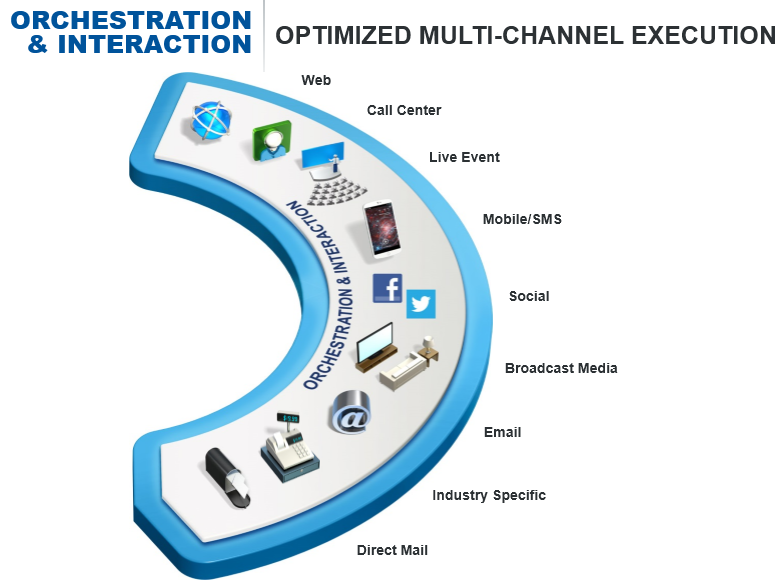This blog post focuses on clarifying what's important in integrated marketing managment, as shown in the second of three sections, titled Orchestration and Interaction. Often when I mention this product category – I receive perplexing looks due to the name we have given to this section in the full IMM visual. Previously we covered the full IMM visual and the first of three sections, Strategy and Planning.
Per the definitions of orchestration and interaction from Wikipedia – “Orchestration" deals with the automated arrangement, coordination, and management of complex computer systems, middleware, and services. Basically, it's the outcome of automation, although some ascribe it with inherent intelligence or even implicitly autonomic control. “Interaction" refers to how two or more objects relate to each other and impact one another.
Our visual simplifies the orchestration & interaction concept by showing the many ways businesses interact with customers and the technologies used to orchestrate those interactions. Let’s dive into a bit more detail around each of these areas.

Web and Call Center – In order to interact with customers via these touch points, an organization must have the capability to react to a request that is initiated by the customer over these channels. For instance, if a customer takes a certain action on your website, such as abandoning a web application form for a product or service, do you have the orchestration capabilities to not only tie that event to past behaviors across marketing channels but the interaction capability to service that action as well? In today’s digital marketplace, this ability is crucial.
Live Event – Live events promoting a product or service are key to showing your customers and prospects that customer engagement matters to your organization. Whether it be a webcast, an industry event, or just an informal networking session - being able to deliver offers and messages via these events is critical to engaging customers when you have their undivided attention.
Mobile, SMS, and Email – Digital marketing, or executing marketing messages over digital channels, is obviously the number one medium for most companies. While SAS supports executing and tracking messages via all of these channels – using these channels in the most effective manner is perhaps what is most important. Using optimization capabilities from SAS combined with the mobile, sms, and email channels – organizations can deliver messages that are anticipated and personalized, and not considered irrelevant spam.
Social – With social now embedded into our social fabric, organizations can expand listening and monitoring social sentiment over time, to reacting and responding over these same social channels. Not only being able to react to a tweet or facebook post with a social service reply – but also sending an unsolicited outbound message over social channels are capabilities that SAS can support.
Broadcast Media – TV advertisements, internet banners, and other broadcast mediums are still effective ways to engage with consumers. Being able to push messages to these channels are supported by the automation capabilities of SAS Customer Intelligence solutions.
Industry Specific Touch Points – Every industry has different touch points that are unique. The self-service ticket kiosk for travel, the ATM for financial services, the point of sale for retail, the slot machine for hospitality and gaming, and so on. To SAS, these present themselves as another opportunity to deliver relevant messaging to drive customer engagement and loyalty. SAS interfaces easily with third party systems – such as point of sale systems – to deliver appropriate messaging.
Direct Mail – We’d be amiss if we didn’t mention perhaps the classic marketing channel - direct mail. Direct mail, if used properly (I’m looking at you credit card companies and retailers) – is an effective medium by which to deliver messaging. Combine marketing automation with optimization when delivering to this channel for the most effective results – avoiding customer saturation and the creation of the dreaded “junk mail”.
Today’s customer interactions must be appropriate, relevant, and personal. This means the right offer, at the right time, via the right channel with the right content. SAS marketing solutions assist organizations in ensuring that customers are contacted in the manner that is best for them – providing valuable – and not annoying – customer engagement over time. Positive customer engagement drives everything that organizations are looking for – retention, loyalty, and growth.
So it should come as no surprise that the products that underpin the orchestration and interaction capabilities discussed above are aptly named SAS Marketing Automation, SAS Real Time Decision Manager, SAS Marketing Optimization, and SAS Digital Marketing. Marketing Automation focuses on outbound campaign management initiatives. Real Time Decision Manager allows organizations to react in real time across inbound customer touch points. Marketing Optimization allows for complex optimization scenarios across campaigns to be carried out. And Digital Marketing is the creation mechanism for the mobile and email digital channels. These products represent the majority of new sales for SAS Customer Intelligence and all four of these products interact with each other to provide the automation that organizations need to execute on marketing initiatives.
SAS’s most recent software release in this area, Customer Intelligence 6, gives marketers a fresh modern new application suite that more tightly integrates the products in this IMM category. This in turn improves the efficiency and effectiveness of all personas inside the marketing organization.
Stay tuned for our next post on managing the customer experience and how SAS can help! As always, thank you for following!

1 Comment
Gone are the days where the call center was the only way that customers could get in touch or voice their concerns. Agents today need to be proficient with multiple channels. Customers expect a response ASAP which means that each channel needs to be properly monitored and maintained.